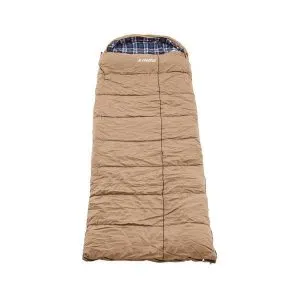Looking for the best sleeping bags Australia?
When on the search for the best sleeping bag for your Australian adventures, it’s important to consider where you’ll be traveling and how you’ll be getting there. Different regions and modes of transportation may require different types of sleeping bags to ensure your comfort and safety.
To help you make an informed decision, we’ve compiled a list of the best sleeping bag options for various needs and preferences:
- All-round sleeping bag: A versatile option that can be used in a variety of environments and temperatures.
- Cold weather sleeping bag: Designed to keep you warm in colder climates, typically with a high temperature rating and insulated construction.
- Lightweight sleeping bag: Ideal for hikers and backpackers who need to minimize weight and space in their packs.
- Down sleeping bag: Made with down feathers for insulation, these tend to be lightweight and compressible, but may not be suitable for wet conditions.
- Synthetic sleeping bag: A good alternative to down, synthetic materials offer similar insulation without the risk of getting wet and losing warmth.
- Hiking sleeping bag: Designed specifically for the needs of hikers, with features such as a hood and draft collar to keep out the cold.
- Budget sleeping bag: A cost-effective option that may not have all the bells and whistles of more expensive models, but can still provide basic warmth and comfort.
- Kids sleeping bag: Designed to fit smaller bodies and often with fun patterns and colors to appeal to children.
- Compact sleeping bag: A space-saving option that can be easily packed and carried for travel or backpacking.
- Sleeping bag for bike touring: A lightweight and compact sleeping bag that can be easily carried on a bike, with features such as a built-in pillow or hood.
Overall, it’s important to consider your specific needs and preferences when selecting the best sleeping bag for your Australian travels.
10 Best Sleeping Bags Australia
If you’re in need of a reliable sleeping bag, check out our list of top picks. These options have been divided into various usage categories, but some may be suitable for multiple types of use.
For example, a sleeping bag that is ideal for bike touring may also work well as a compact option. Take a look at our selection and see if one catches your eye. These are all high-quality products, so you can’t go wrong with any of them.
Best Down Sleeping Bag
The North Face Eco Trail Down Sleeping Bag is a top contender for the title of best down sleeping bag due to its impressive features and eco-friendly construction. Some key points to consider include:
- Fully recycled materials, including natural down fill, make this sleeping bag a great choice for those looking to reduce their environmental impact.
- With a lower limit of -7°C, this sleeping bag is well-suited for colder weather.
- The tapered shape helps to preserve body heat, while the fitted hood provides added warmth and comfort.
- The J-zip arrangement allows for increased mobility and ventilation, and the water repellent finish helps to keep you dry in damp conditions.
- At just 1.3kg, this sleeping bag is super lightweight and packs down to a compact size of 23cm x 41cm, making it easy to take on the go.
Overall, the North Face Eco Trail Down Sleeping Bag is a fantastic option for those in need of a high-quality, eco-friendly sleeping bag that can handle colder temperatures. For more information and the latest price, click here.
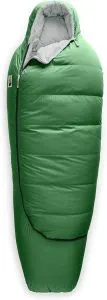
Best Synthetic Sleeping Bag
If you’re in the market for a synthetic sleeping bag, the North Face Eco Trail Synthetic is a top choice. Not only is it made with fully recycled materials, making it an eco-friendly option, but it also boasts a water repellent outer and synthetic insulation that is almost completely waterproof. With a lower limit of 20°C, this sleeping bag is suitable for a variety of temperatures. Additionally, it packs down to a compact size of 22cm x 38cm, making it easy to transport on your outdoor adventures.
In terms of features, the Eco Trail Synthetic is on par with the North Face Eco Trail Down sleeping bag. So if you’re looking for a synthetic alternative, this is a great option to consider. For more information and the latest price, click here.
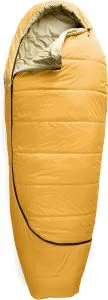
Best Kids Sleeping Bag
If you’re looking for a reliable and affordable option for your child’s sleeping bag, the Oztrail Lawson Jr is an excellent choice. This compact and lightweight bag is perfect for kids and smaller adults, and comes in a variety of colors. With a weight of just 1.2kg and a packed size of 31cm x 20cm, it’s easy to transport and store.
Featuring a non-allergenic ExoTherm fill, the Oztrail Lawson Jr boasts impressive insulating properties, keeping your child warm in temperatures as low as -5°C. The cocoon-style lip hood adds extra warmth, while the option to zip two bags together allows for a double sleeping bag.
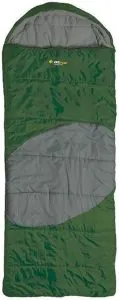
Best All-Round Sleeping Bag
If you’re in the market for a high-quality, versatile sleeping bag that won’t break the bank, the Adventure Kings Premium Winter/Summer Sleeping Bag is an excellent choice. This sleeping bag is made from water-resistant polycotton and has a lower limit of -5oC, making it suitable for a wide range of temperatures. It’s also generously sized, measuring 240cm x 90cm, so it can comfortably accommodate most people.
One of the standout features of the AK Premium Sleeping Bag is its zip-out flannel liner, which allows you to adjust the temperature range to suit your needs. Whether you’re camping in the summer or winter, this sleeping bag will keep you warm and comfortable.
Additionally, you can zip two AK Premium Sleeping Bags together to create a jumbo double sleeping bag, as long as the other sleeping bag has a zip on the opposite side. This sleeping bag is also designed to fit inside the AK Big Daddy swag, making it an excellent option for extended camping trips.
One potential downside to this sleeping bag is its weight, which comes in at just over 5kgs. However, this may be a worthwhile trade-off for the many benefits it offers.
For more information on the AK Premium Sleeping Bag, including customer reviews and the latest price, click here.
Best Cold Weather Sleeping Bag
If you’re in need of a reliable cold weather sleeping bag, the Darche Cold Mountain 900 should definitely be on your radar. With a lower temperature limit of -12°C, this sleeping bag is well-equipped to handle the colder nights. Its double-layered design adds an extra layer of insulation to keep you warm and cozy.
In terms of size and weight, the Cold Mountain 900 is quite impressive. It weighs just 2.7kg, yet offers a generous 250cm x 90cm of space. Plus, it has a shaped hood to keep your head and neck warm.
One of the standout features of this sleeping bag is its versatility. You can unzip it to use as a doona, or zip it together with another Cold Mountain sleeping bag to create a double. This makes it a great option for couples or families who want to share a sleeping bag.
Overall, the Darche Cold Mountain 900 is a high-quality, competitively priced sleeping bag that’s perfect for cold weather camping. Check out the details and latest price by clicking here.
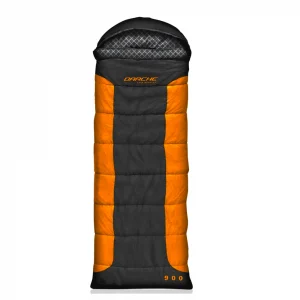
Best Lightweight Sleeping Bag
When it comes to choosing the best lightweight sleeping bag, it’s important to not sacrifice quality for the sake of weight. That’s why our top pick is the Marmot Always Summer Sleeping Bag.
This sleeping bag is perfect for bike touring and kayakers, weighing in at a mere 760 grams and packing down to just 4.2 litres. It has a lower temperature limit of 4oC, making it suitable for three seasons. Its insulation, made with a 650 fill-power rating, ensures warmth while the polyester materials provide durability.
Overall, the Marmot Always Summer Sleeping Bag is a top choice for those looking to save space and weight without sacrificing quality. Click here for more details and the latest price.
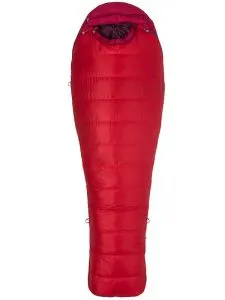
Best Hiking Sleeping Bag
If you are on the hunt for a hiking sleeping bag, there are a few key considerations to keep in mind. Firstly, it’s important to prioritize a compact size and lightweight design, as these features make it easier to carry the bag on long hikes. Additionally, it’s important to find a bag that has a reasonable season rating, ensuring that it will keep you warm in a variety of weather conditions.
With these factors in mind, the Vango Nitestar Alpha 300 Quad Sleeping Bag is an excellent choice for bushwalking and hiking enthusiasts. Some of the standout features of this bag include:
- A weight of just 2kg, making it easy to carry on long hikes
- A packed size of 29cm x 24cm, ensuring that it won’t take up too much space in your pack
- A spacious interior, measuring 205cm x 78cm, providing plenty of room to move around
- A lower temperature limit of -3oC, ensuring that it will keep you warm in cold weather
- A synthetic Insulite fill, which provides a good balance of warmth and durability
For more information on the Vango Nitestar Sleeping Bag, including the latest price, be sure to check out eBay Australia. So, it can be a good choice for your next hiking or bushwalking adventure.
Best Sleeping Bag for Bike Touring
As a bike tourer, you know the importance of having a lightweight and compact sleeping bag that can withstand harsh outdoor conditions. That’s why a down-based sleeping bag is your best bet. One option to consider is the Blackwolf Hiker 300 4C Sleeping Bag.
Here’s what you need to know about this sleeping bag:
- Weighs only 0.9kg and packs down to 27cm x 15cm for easy storage on your bike.
- Features a lower limit of -1oC, making it suitable for colder temperatures.
- Filled with 700+ loft water-repellent duck down for optimal warmth and comfort.
- Tapered shape measures 220cm x 80cm (chest) x 50cm (feet) and is designed specifically for bushwalking, trekking, and lightweight travel.
If you’re planning on cycling through cooler areas, the Vango Venom may be a better choice. But if you’re looking for a high-performing sleeping bag for bike touring, the Blackwolf Hiker 300 4C Sleeping Bag is worth considering. To learn more about this product and check out the latest price, visit Tentworld.
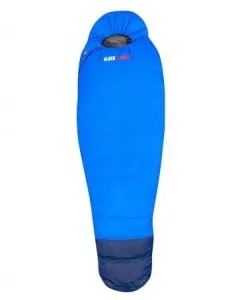
Features and Benefits of the Best Sleeping Bags for Australia
When looking for a sleeping bag for use in Australia, there are a few key features to consider. In this article, we’ll explore the benefits of these features and how they can improve your outdoor experience.
Sleeping Bag Fill
When it comes to choosing a sleeping bag, the fill is an important consideration. The fill is the material that provides insulation and helps to keep you warm while camping. There are two main types of fill – natural and synthetic.
Natural fill is typically made from goose down, which is the soft, fluffy plumage found under the outer feathers of a goose. Some of the benefits of natural fill include:
- Effectiveness as an insulator: Down is nature’s way of keeping birds warm, so it is a highly effective fill.
- Lightweight and compact: Down is very light and doesn’t take up a lot of volume, making it a great choice for those who are looking to save space and minimize weight.
- Durability: Down is known for its durability and can last for many years with proper care.
However, there are also some potential downsides to natural fill, including:
- Cost: Natural fill is often more expensive than synthetic options.
- Waterproofing: Natural fill is not as waterproof as synthetic counterparts, so it may not be the best choice for wetter environments.
- Ethical concerns: Some people may have ethical concerns about using animal products in their sleeping bag.
Synthetic fill, on the other hand, has been evolving and improving for decades. Some of the benefits of synthetic fill include:
- Cost-effectiveness: Overall, synthetic fill is generally more affordable than natural fill.
- Waterproofing: Synthetic fill has better waterproof properties than natural fill, making it a good choice for wetter environments.
However, there are also some potential drawbacks to synthetic fill, including:
- Insulation: Synthetic fill is not as effective at insulating as natural fill.
- Volume and bulk: Synthetic fill tends to take up more volume and make the sleeping bag bulkier.
So, which is the best choice – natural or synthetic fill? It really depends on your individual needs and preferences. If cost, waterproofing, and convenience are important considerations, synthetic fill may be the way to go. However, if you’re looking for top-performing insulation, lightweight, and compact size, natural fill may be the better option. Ultimately, it comes down to your personal preferences and the conditions in which you’ll be camping.
Seasonal Ratings
If you are choosing a sleeping bag, the season rating is an important factor to consider. In Australia, there are five categories to choose from:
One season: These are the lightest and coolest sleeping bags, designed for use in warm climates or during the summer months.
Two season: Similar to one season sleeping bags, but with the added ability to be used in a wider range of temperatures including spring, summer, and autumn.
Three season: These sleeping bags are highly versatile, suitable for use in spring, summer, autumn, and warmer winter nights. These are a popular choice for travelers in Australia, as they offer a balance between flexibility and comfort.
Four season: These sleeping bags are designed for colder nights, featuring a hood and a body-hugging shape to help retain body heat.
Expedition: Also known as five season sleeping bags, these are the heaviest and most specialized option. They are fitted with hoods and have minimal internal room to retain heat, and are made with waterproof, breathable outer material to protect against rain and snow. These are best suited for extreme environments.
Sleeping Bag Temperature Ratings
When shopping for a sleeping bag, it’s important to consider the temperature rating. There are international standards for this, including the European standard EN 13537 and its successor, the ISO standard EN 23537. While these standards are not legally required for manufacturers in Australia, reputable brands will often follow them when labeling their products.
Here are the four temperature measures that manufacturers typically consider:
- Upper Limit: This is the highest temperature at which you can sleep without excessive sweating or discomfort.
- Comfort: As the name suggests, this is the optimal temperature for a comfortable night’s sleep.
- Lower Limit: This is the lowest temperature at which you can still sleep comfortably.
- Extreme: This is the temperature range in which the sleeping bag is meant to prevent hypothermia and frostbite. It is not recommended to use a sleeping bag in these extreme conditions.
For more information on the criteria and calculations used for these temperature ratings, you can refer to the EN 13537 standard on Wikipedia.
Fill or Loft Power
When shopping for a sleeping bag, you may come across a term called “fill or loft power.” This rating is expressed as a three-digit number, typically ranging from 300 to 900. The higher the number, the better the quality of the fill material used in the sleeping bag.
But what exactly does fill power mean? Simply put, it refers to the ability of the fill material to loft or fluff up, which in turn affects the insulation properties of the sleeping bag. Fill weight, on the other hand, refers to the amount of fill material used in the sleeping bag.
In general, a sleeping bag with a fill power of 550 or above is considered to be of good quality. So, if you want a reliable and comfortable sleeping bag, be sure to keep an eye out for this rating.
Sleeping Bag Shapes and Sizes
As you are selecting a sleeping bag, one of the key considerations is the shape and size. There are three main options available: rectangular, mummy, and tapered.
Rectangular sleeping bags offer the most room and flexibility. These are typically used in warmer climates and can often be unzipped and used as a makeshift doona or cover.
Mummy sleeping bags are designed to have a snug, body-hugging shape, which helps to reduce weight and retain heat. These are popular with bushwalkers and hikers heading into more extreme environments and often feature a hood for added warmth.
Tapered sleeping bags provide a compromise between rectangular and mummy shapes, with a narrow foot area but less body-hugging design than a mummy bag. Some tapered sleeping bags may also feature a hood.
Ultimately, the shape and size of sleeping bag you choose will depend on your personal preferences and the type of activities you plan to undertake. Consider factors such as the climate, your intended use, and the level of warmth and comfort you require to help make the best choice for your needs.
Other Things to Look For
When shopping for a sleeping bag, there are a few key features to consider in order to ensure the best possible experience. These include:
- Quilting/baffles: These features help to keep the filling evenly distributed, preventing the development of lumpy spots.
- Weather proofing: Look for a sleeping bag with water-resistant outer material to protect against condensation, even in colder temperatures.
- Liners: Using a sleeping bag liner can help to keep the inside of your sleeping bag clean and hygienic.
- Temperature range: Consider your own sleeping habits when selecting a temperature range for your sleeping bag. Are you a warm sleeper or do you need extra blankets to stay comfortable at night?
- Age: If you are shopping for a sleeping bag for a child, keep in mind that their needs may be different from those of an adult.
- Size: If you prefer extra space while sleeping, consider a double sleeping bag.
By considering these factors, you can make an informed decision and choose the best sleeping bag for your outdoor adventures.
****
Further Reading and Resources
We strive to provide our readers with the necessary information to make informed purchasing decisions. That’s why we’ve compiled a list of resources on camping gear to help you find the best products for your needs.
Here are some of the topics covered in our Camping Gear Buying Guides:
